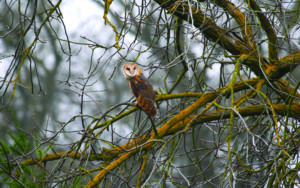
July/Aug 2022
Barn owls for rodent control
There’s a variety of approaches to solving pest issues. For rodent control, the most common options are costly in time and/or money, and some are harmful to the environment.
But there is another option: owl boxes.
An owl box program is not only environmentally safe, but can also save both time and money. They’re growing in popularity across the country for rodent control on farms.
So, how does the program work?
Emulating nature
“It works like nature. What we’re simply attempting to do is bring back a certain amount of balance to monoculture,” said Mark Browning, owner of Barn Owl Box. “When we create monoculture, we create a tremendous food source for pests, and that doesn’t tend to leave much room for predators that can help with that balance.”

There are many predatory birds (raptors) – such as the great horned owl and red-tailed hawk – that can help suppress rodent pest populations. While areas in the country have a variety of migratory and resident raptors, these species are far more territorial and tend to push out other raptors and non-predatory birds. While territoriality generally happens the most among birds of the same species, a few can exert influence on other large birds in the area, but luckily not particularly against barn owls.
“Barn owls have the unique characteristic of being colonial, in a sense,” said Browning. “They don’t have a high amount of territoriality toward each other, and they can be established in dense colonies in areas where there are dense numbers of their prey.”
Another unique characteristic of barn owls is that they have large numbers of young – sometimes several per nest box. With this population density, barn owls can create a greater effect on the rodent populations within an orchard because they are relentless in their pursuit of prey, especially during rodent breeding season. While it isn’t possible to saturate a field with territorial raptors, it is possible to saturate a field with barn owls, making them a quintessential choice for rodent control.
Set it and forget it
There are thousands of owl boxes placed around the country in a variety of crops, including tree nuts, with an emphasis on walnut, pecan and almond. A mission of this program is to establish a network of homes for raptors around orchards.
For growers, it’s a “set it and forget it” scenario, requiring the initial investment and installation and little else aside from minor maintenance, unlike baits and traps. As a cavity-nesting raptor, barn owls look for enclosed cavities, such as in hollow trees or caves or cliffside hollows – all uncommon things in an orchard.
“Barn owl nesting sites are scarce, and because nesting sites are scarce, a nest box readily attracts barn owls and pretty quickly, too,” said Browning.
In a high-density prey situation, one nest box per every 10 acres may be optimal, but one for every 20 acres is the minimum. In a cost study, Browning found that the cost of trapping each pocket gopher was around $8 each. Using barn owls, the cost dropped drastically to $.25 each. This included the costs of the barn owl boxes, and the poles and labor to erect them and maintain them.

This is wrapped into one initial investment. To start a nest box program on a 100-acre block, 10 barn owl boxes would run about $2,500, another $1,500 for poles if growers don’t already have their own, and the labor to install them. A barn owl program like this, Browning said, could cost about $5,000, whereas trapping pocket gophers and voles on the same acreage would cost closer to $8,000 and would require much more labor, and could be a recurring cost in following years.
“Barn owls run on their own hunger and are more motivated than a farmer, who would need to trap or poison, both of which are time intensive,” said Browning.
There is also the added effort in changing or removing a rodent pest’s habitat to prevent reinfestation.
Starting on the East Coast several years ago, the initial nest boxes were made of wood. But with climates like those in Georgia and Pennsylvania, the wood wouldn’t last the season. Now, the boxes are made of new materials and patented as a heat-resistant animal enclosure with a number of unique features, including a double-box system in which one box fits inside the other with an airspace all around, allowing for efficient venting. The outer box reflects high amounts of sunlight, which is particularly important in regions of intense sunshine, such as California and the Southwest.

Protecting the environment
One of the most important aspects of the program is that it’s environmentally safe, without any crop damage or collateral damage to the biodiversity of the surrounding areas. Invasive poisons, such as strychnine, is effective pest control, but can also harm unintended targets if not used properly. Poison pellets are approved for below-ground bait applications only. Unfortunately, there is still misuse and improper bait application.
“The point of using owl boxes is to reduce the use of poisons,” said Browning.
Another problematic and destructive, but still accepted, practice in many areas is the injection of propane and compressed oxygen into rodent burrows, which is then ignited. This incinerates not only the rodents, but any other animal living in those tunnels that are important to biodiversity, including endangered species.
Browning’s company places about a couple thousand boxes across the U.S. every year. What started as an effort in conservation was more quickly and widely accepted by farmers as an environmentally friendly and cost-effective use for rodent control.
“Each time I set a nest box, the overall habitat for nest boxes is enhanced. One of the main conservation methods for barn owls and other animals is to enhance habitat instead of trying to increase numbers by breed-and-release or other methods,” said Browning. “It’s a win-win situation for everybody.”
Post model owl box. Photo: Mark Browning







